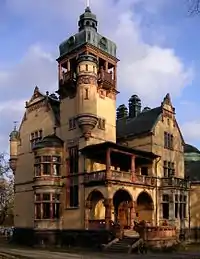
Villa Lusthusporten, also called villa Wicanderska, villa Brinckska, and villa Liljevalchska, is a 19th-century merchant's house on Djurgården road, north of Djurgården, in Stockholm.[1]
History
Djurgården was originally an enclosed hunting area with entrances through multiple gates. In 1600 there was a gazebo which gave its name to the nearby gateway. There was also an inn named 'Lusthusporten', but it was burned down in the 1869. In 1873 the trader Brink leased the land to architects Axel and Hjalmar Kumlien who built then a house on the site.[2]
The small house was built in Italian style, forming the backbone of the existing house. During the great General Art and Industrial Exposition of Stockholm (1897), the villa was temporarily used as press office and police station.[2]
The building was sold to the cork magnate Hjalmar Wicander in 1898 and he commissioned architect Carl Möller to remodel the house to its present appearance of a Baroque Revival architecture with Art Nouveau decor considered fashion at the time. Later the site was reduced in favor of a public promenade and the villa fenced with an iron railing.[1]
Museum
In 1940 Villa Lusthusporten was donated to the Nordic Museum Foundation when the Institute of Ethnology was established. The building is now a national monument.
See also
References
- 1 2 Rörby, Martin. "I spåren av Stockholmsutställningen 1897". Byggnadsvårdsföreningen. Archived from the original on 4 March 2016. Retrieved 28 August 2011.
- 1 2 Svenska sällskapet för antropologi och geografi (1976). Ymer: Volume 95. Generalstabens litografiska anstalts förlag. p. 170. OCLC 1644580.
External links
 Media related to Villa Lusthusporten at Wikimedia Commons
Media related to Villa Lusthusporten at Wikimedia Commons
59°19′43.25″N 18°5′51.18″E / 59.3286806°N 18.0975500°E